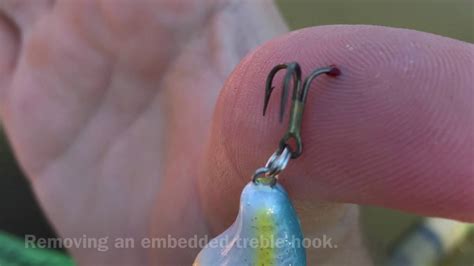How To Remove A Treble Hook From A Fish
Ronan Farrow
Apr 02, 2025 · 3 min read

Table of Contents
How to Remove a Treble Hook from a Fish: A Humane Guide
Fishing is a rewarding hobby, but it comes with responsibilities. Knowing how to safely and humanely remove a treble hook from a fish is crucial for ensuring its survival and well-being. This guide provides step-by-step instructions and crucial safety tips for handling this delicate process.
Understanding Treble Hooks and Fish Handling
Treble hooks, with their three sharp points, can cause significant injury to a fish if removed incorrectly. Improper removal can lead to internal damage, infection, and ultimately, death. Therefore, patience and the right technique are vital. Always prioritize the fish's safety and well-being.
Essential Tools for Hook Removal
Before you begin, gather the necessary tools. While you can sometimes remove a hook with just your hands, using the right tools minimizes injury to both you and the fish:
- Long-nose pliers: These provide excellent grip and leverage for removing deeply embedded hooks.
- Hook remover: A specialized tool designed to dislodge hooks efficiently and with minimal trauma.
- Gloves (optional): Protect your hands from sharp hooks and possible fish slime.
- Wet towel or cloth: Helps to keep the fish moist and reduces stress.
Step-by-Step Guide to Removing a Treble Hook
Remember, gentle movements are key throughout this process. Any sudden or forceful actions can injure the fish.
1. Assess the Situation
Carefully examine where the hook is embedded. Identify which hook point is easiest to access. Sometimes, cutting the line close to the fish's mouth is the best option, particularly if the hook is deeply embedded.
2. Grasping the Fish
Handle the fish firmly but gently. Support its body to minimize stress. Wet your hands or use a wet towel to maintain a secure grip and keep the fish's scales moist. Never squeeze the fish excessively.
3. Using Long-Nose Pliers
If using long-nose pliers, carefully grasp the hook shank (the long part of the hook) as close to the fish's mouth as possible. Avoid squeezing the fish's flesh. Gently pull the hook outward, following the path it entered.
4. Using a Hook Remover
If you have a hook remover, follow the manufacturer's instructions. These tools are typically designed to slide under the hook and dislodge it with minimal effort.
5. Cutting the Hook (If Necessary)
If the hook is deeply embedded and removal is proving difficult, consider cutting the barb (the small outward-pointing projection on the hook) using wire cutters. This will allow for easier removal. Only do this if you are comfortable and confident you can remove the remaining hook shank.
6. Post-Removal Care
After removing the hook, check for any lingering injuries. If necessary, gently rinse the wound with clean water. Do not attempt to disinfect the wound. Release the fish back into the water. Allow it to recover in a calm area.
Preventing Hooking Injuries in the First Place
Preventing hooking injuries is always better than having to remove a hook. Consider these tips:
- Use barbless hooks: These are easier to remove and cause less damage to the fish.
- Practice proper casting techniques: Avoid casting into areas where you might accidentally hook a fish.
- Properly handle the fish after catching: Keep it in the water as much as possible to minimize stress.
By following these steps and prioritizing humane handling, you can ensure the well-being of the fish while enjoying your fishing experience. Remember, responsible angling practices benefit both the fish and the sport.
Featured Posts
Also read the following articles
| Article Title | Date |
|---|---|
| How To Ski Snowbird | Apr 02, 2025 |
| How To Size A Goalie Stick | Apr 02, 2025 |
| How To Start An Alcohol Brand | Apr 02, 2025 |
| How To Treat Histamine Reaction After Waxing | Apr 02, 2025 |
| How To Read Scarlett St Clair Books | Apr 02, 2025 |
Latest Posts
-
How To Wash Jelly Cat
Apr 03, 2025
-
How To Wash Hair After Neck Surgery
Apr 03, 2025
-
How To Wash Hair After Breast Augmentation
Apr 03, 2025
-
How To Wash Game Bags
Apr 03, 2025
-
How To Wash Car Without Water Spots
Apr 03, 2025
Thank you for visiting our website which covers about How To Remove A Treble Hook From A Fish . We hope the information provided has been useful to you. Feel free to contact us if you have any questions or need further assistance. See you next time and don't miss to bookmark.
